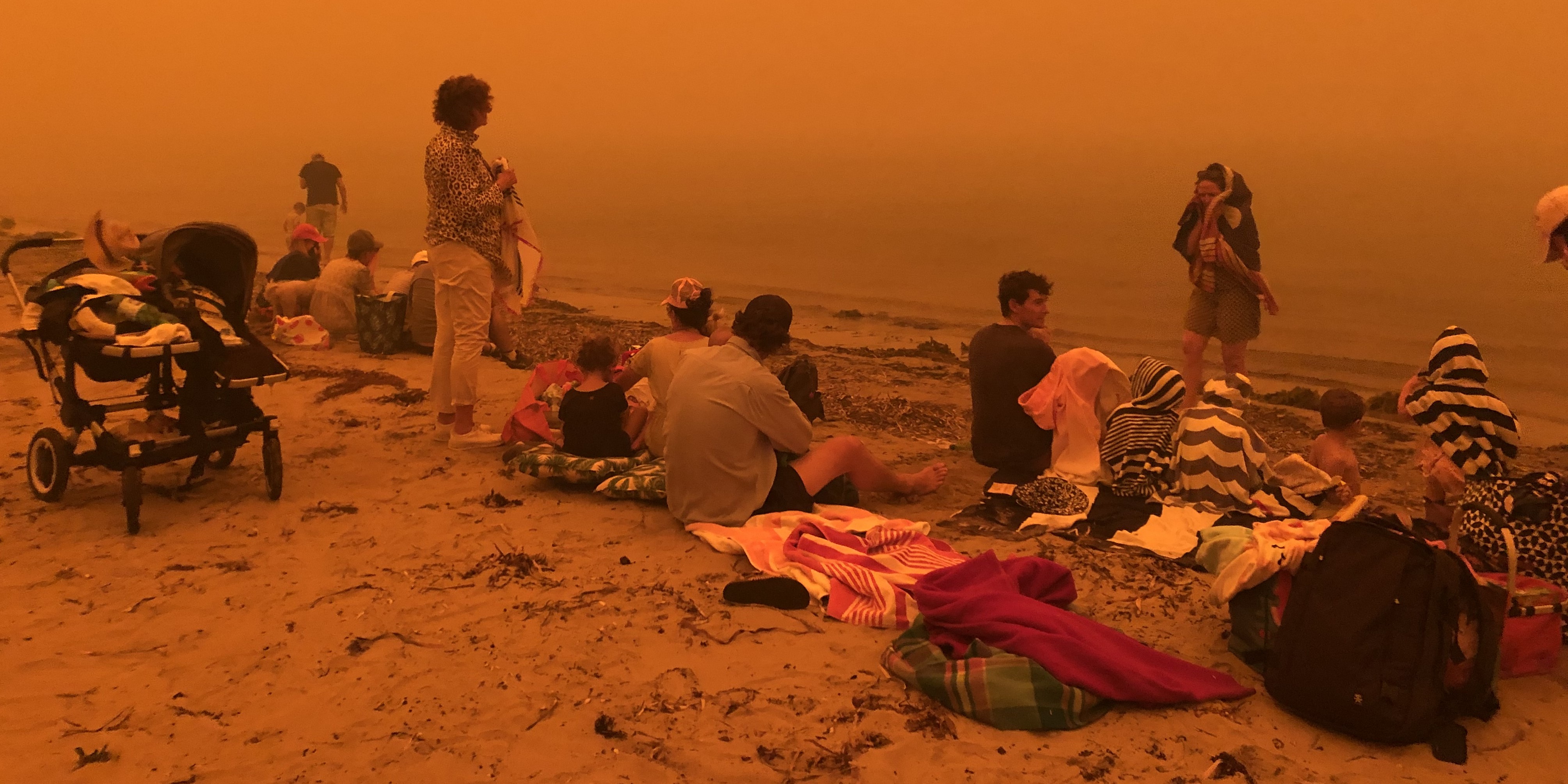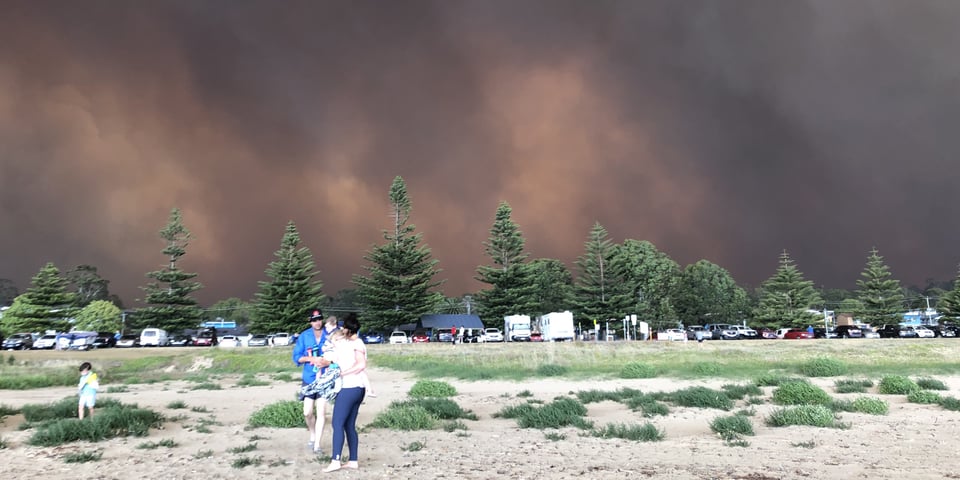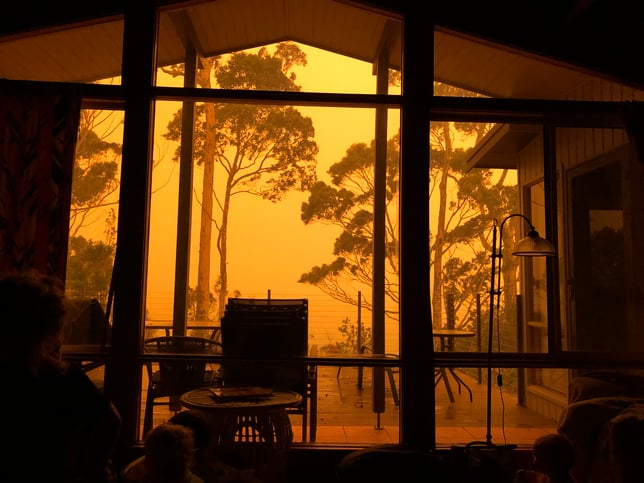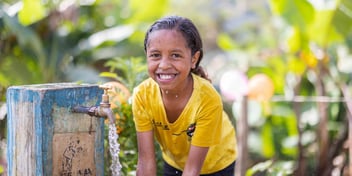What the 2019-20 bushfires revealed about water and sanitation in Australia, from someone who was there

The family on the beach engulfed by smoke. Image: Isobel Davis
Water and development consultant Isobel Davis had a challenging firsthand experience of the bushfires that ravaged Australia’s east coast this past summer. Here, she shares what it was like to suddenly find herself without access to water, sanitation and hygiene – and how we could be better prepared for natural disasters.
It is late December on the south coast of New South Wales (NSW) and I am settling into a seaside summer holiday week at my parents’ house near Batemans Bay. My brother and sister and their families have arrived and between us we have nine kids under seven. We keep them inside in the morning, but as the smoke clears with some sea breeze later in the afternoon, they tumble outside. Their grandparents have given all of them matching Christmas pyjamas and their joy sparks a dance party on the dry lawn.
The next morning, we are woken by a Rural Fire Service (RFS) volunteer at 6.30am, evacuated by 7am and the house is gone before 9am on New Year’s Eve.
Then, all of a sudden, we are on the beach. The hot, windy, sandy and smoky beach.
We go to the beach at Batehaven because the road, playground and car park provide a buffer between the bush and the beach. We fill up water bottles before leaving, and I am suddenly conscious that the kids' ones are only 400 ml; normally all they need between places with taps that work.
At first, we are in the playground area, with toilets and a water bubbler. It is the first step in a transition from resource abundance to less and less as the day and subsequent days wear on. The service station is open, so we buy some more bottled water, but there is no way to keep any of the water with us cool.
My sister-in-law is pregnant and not feeling well in the heat, smoke and uncertain situation. We worry about her and the kids.
The heat and wind build as the fires ravage through, so we move down onto the beach. The wind is blowing sand, dust and ash, which quickly coat every family member. We look at each other, not saying much, not thinking much as we have no information, but all worrying about the kids – especially the one year old and the two year olds with us. Will they tell us if they are thirsty? Why won’t they drink more? Are they ok? Is it good they have fallen asleep or is the smoke affecting them? We see people pouring onto the north end of the beach, and flames arriving.
We move to the south end against the cliff, which is a little protected from the wind. We change nappies on the beach. A four year old needs to poo and goes behind a small tree nearby. We have wipes, nappies and hand sanitiser between us but we are all aware they are in limited supply. We are washing hands in an ash-filled ocean and the kids wade in where they are bitten by sea lice.

Heading to the beach as the fires come closer. Image: Isobel Davis
My cousin, her fiancé, his aunt and uncle and mum and their three dogs are with us having evacuated from Rosedale. We share what snacks and water we have. We use every plastic bag we find.
My dad, brother and husband tell the story of when they left the house, having stayed until the fire came over, trying to defend it. My dad has bushfire experience, including many years in his local RFS. The tank water supply at the house had been cut. The town supply, for which my parents must pay the minimum administration connection fee, does not actually reach up onto the ridge where the house is, or was. My husband and brother were using a wheelbarrow with pool water and the kids’ Christmas super-soakers to put out spot fires. The fire came across the lawn, the shed next to the house went up and they fled.
We watch Elvis the helicopter drop loads of water from the bay onto the fire at the other end of the beach and wonder if it will reach us.
"We have become so used to our water flowing from a tap, our functioning toilets and an array of hygiene and cleaning products. We have no reference for being in a humanitarian disaster."
In the early afternoon a DC-10 trijet flies alarmingly low overhead, releasing fire retardant just to our north. The wind changes and the smoke engulfs us, turning everything orange.
From then on, for what feels like forever, we cannot see properly. I can feel the smoke in every breath. I use a little water to dampen a t-shirt and cover my mouth. I try to cover the kids’ mouths and they push me away.
A woman from a house nearby arrives and offers refuge for the elderly, kids or asthmatics in her home out of the smoke. She cannot fit everyone, but she kindly offers what space she has.
At that point we decide to move to a relative’s house on the hill. It is surrounded by beautiful tall trees and we have been avoiding it due to the risk of embers, but the tipping point has come with the smoke.
We decamp. It is orange and dark at 4pm. There is no power. The water is being used to wet the house. We fill up water bottles again in case it is cut. All the adults use the toilet and wash their hands, having avoided it as long as possible on the beach. The roads are closed to the north and south. The internet and communications are down. My husband goes around switching off iMessage – mobile calls and texts can still go through, but we have become so dependent on internet communications that we have forgotten there are options beyond WhatsApp.
We have become so used to our water flowing from a tap, our functioning toilets and an array of hygiene and cleaning products. We have no reference for being in a humanitarian disaster.
The neighbours come and offer us spaghetti bolognaise as their freezer is defrosting and they have a stash to feed us all. I cannot flush their loo; it is on its own small septic system and there are too many people. As I bucket flush, I think, "Thank goodness I had my period last week".
As smoky day becomes smoky night there is not enough room for everyone to sleep. The house next door is empty and the neighbours make contact and reassure us that it will be fine to stay there. “They’ll be happy they weren’t here,” they tell us. We go in through the patio door and say a silent thank you to the absent family.
We are aware staying here is putting pressure on resources, so we plan to sleep for a few hours and try to drive out the next morning. Roads are shut and fuel is tight for a few of the families with us, so we do not know how far we will get. But it feels important to move closer to safety.
At 3am I am woken by a general restlessness and the smell of smoke in the air. My two year old is coughing and starts retching as I pick him up. I hold my baby in the dark as he retches, and I think, “I have nothing to clean him with. Please, don’t let him vomit on these kind people’s carpet”.

Able to breathe indoors but waiting to see if we are safe. Image: Isobel Davis
After a short, fitful rest, we are up at 5am. We pack water and bananas and children in the cars. My nieces are crying. I hug my parents before heading out and they say they feel like they let us down. I look at my dad and say, “Are you serious? We’re all adults, we are all responsible for where we find ourselves and for the state of the climate, the systems and services around us and the government who leads and supports us”.
Everyone is tired, anxious and teary. We are safe and grateful, but the house is gone and we all just need to leave. Half of us north, the others south back to their farms. The evacuation centre is doing an amazing job, but it is full with thousands of people.
It is New Year’s Day and everything is closed. There are long lines at the service station. Each car waits for the car in front to pay before the next can refuel. Cash only, as the lack of internet means EFTPOS payment is down. Our ute has fuel but my brother's tank is near empty and he has no cash – thankfully we can lend him some to pay. “Do you need anything?” he asks. “Just water,” we reply. Bottles, plastic, rubbish, waste. No way of recycling. Our normal habits and values out the window in this situation.
We drive an hour down the road. My little one vomits bile into a plastic bag and the smell mixes with dust and smoke. There is ash in our eyes and ears. I worry about how this will unfold from a hygiene standpoint. The Princes Highway is still closed at Milton.
"Suddenly, civilisation. I am so grateful for the abundant water resources, the shower and washing machine. The smell of smoke is everywhere."
We turn around. Luckily, I know of a friend close by, and we knock on her door at 7am. She opens it in pyjamas and says come in, there is no power, but we have some leftover food. They have a toilet, soap and water. The other cars we passed, parked on the side of the road waiting, must make do with the bush and what they have. A café somewhere along the beach has a generator and will serve the long queues of people what they can until they run out. The playground is full. Summer holiday makers stuck and waiting. Two toilets for hundreds of people. Told to evacuate but the roads are closed so there is nowhere to go.
Our friends have a rare piece of ancient technology – a battery-powered FM radio. The ABC emergency service is talking about the lack of power and fuel in the area. At 10pm my brother and sister-in-law get through to the information line, and then so do we. They say there is a chance the roads will open at 2am. My husband prepares. I say perhaps we should let the kids sleep a little and leave at 5am. He replies that if the roads open at 2am we are going then.
We go. It is pitch black, there is hardly a soul on the road, just the light of small fires and trees still burning and lights of police cars blocking exits. We pass two fuel tankers and no one else on the way back to my in-laws’ in Sydney.
Suddenly, civilisation. I am so grateful for the abundant water resources, the shower and washing machine. The smell of smoke is everywhere and makes us all anxious. We wash our clothes and take the car to a carwash. We dismantle the travel cot and attempt to wash away the scent of crisis.
It takes days to recover. I wake in the night with smoke in the air; I jump out of bed in fear to check on the kids and slam closed the windows. A few days later, gastro hits the family and hygiene becomes our top priority, again. The fires continue to rage, and the temperatures increase. Everything feels more fragile. Nowhere is safe.
Reflections on the crisis
My family and I are fortunate to be educated and to have access to technology and resources. And yet this situation was extremely challenging in every way – particularly finding water and being able to practice proper hygiene. I am aware that the regular decisions and choices that have to be made for survival are even more challenging in other regions with less developed infrastructure, shelter and resources.
As a water professional, I am struck by how much my personal experience highlighted the need for resilient water and sanitation systems that can provide for basic needs during natural and humanitarian disasters.
My first and most immediate reflection was on the need to ensure sustainable water availability. The bubblers and taps on the beach became a lifeline, not a luxury, during a crisis when people were driven from their homes by fire. The reusable bottles that my family carries everywhere were nowhere near big enough to last a day when there was no opportunity for a refill.
Water was flying off the shelves of every store – how many people were seriously dehydrated in hot, smoky conditions because they just could not get a drink? Bottled water is helpful and hygienic, but how sustainable is it for our environment? What are the trade-offs between convenience and hygiene on the one hand, and the environmental cost of trucking in pallets of water and managing the resulting waste on the other?
The HMAS Choules, which supported the evacuation of Mallacoota, has two reverse osmosis plants that are able to support the water needs of the 1100 people on board. Should we be thinking more about regional water resilience technologies for disaster relief?
Second, I have been reminded that in a disaster everyone still has basic sanitation and hygiene needs. These needs become even more important and difficult to manage when people are without their habitual modern services, which quickly becomes hazardous to health.
"As a water professional, I am struck by how my personal experience highlighted the need for resilient water and sanitation systems that can provide for basic needs during natural and humanitarian disasters."
I recall the significant investments being made in behaviour-change in sanitation and hygiene in developing countries and feel that these principles could be applicable in the developed country context. It is important for people to understand how to safely manage faecal matter for themselves and for the community around them. When you grow up with a toilet most people do not even think about it, nor do they understand the spread of disease. I know I have seen grown adults not washing their hands. Soap and how to use it effectively to wash your hands is one of the biggest gaps in water, sanitation and hygiene in emergencies. Now, with the COVID-19 outbreak, we are seeing how critical access to soap and water is for disease prevention on a daily basis.
At 6am on New Year’s Eve, we received an emergency services message telling us to “leave now to the east towards the beach and shelter in place”. However, the alert mentioned Mogo, a neighbouring town and area. The message for our beach came through at 9.28am, telling us to “seek shelter when the fire arrives” – by then the house was already gone.
In the future, these channels could be used for important health and hygiene messages However, if smoke affects the satellite precision and ability of messages to go through, we need to find other solutions. The radio was a critical information service and broadcasters may have discussed water and hygiene, but what I heard was focused on roads, power and fuel, along with fire progress updates.
The RFS website, a key source of critical information and support, or other relevant sites could also provide information on emergency water, sanitation and hygiene. We were able to handle our subsequent gastro with toilets, soap and rehydration salts. But it pains me to think about what happens if we were still stuck without these. My mum and cousin experienced violent vomiting and panic attacks the day after the fires, with no access to medical care. People in natural disasters get on with it silently, and most recover, but I believe we can avoid some hygiene-related stress or support its management with preparedness.
Thirdly, while keenly focused on the human experience of this catastrophe, I was also aware of the broader water-related ecosystem and potential water quality issues that the fires threaten. Ash, dust and rubbish have been swirling into waterways, the access to water cut, and in the following days and weeks south coast towns were told to boil their water before drinking. Beaches have been closed. The toilet pipes burst in our local beach car park, prompting closures and having a significant impact on the café and small businesses nearby. Everything felt quite reactionary and a little too late.
I hope we can use the water impact data that will be forthcoming in order to justify early intervention, to strengthen drought, fire and flood preparedness and ensure that we protect the environment and waterways before and after these types of disasters. Our national and state policies and plans must keep pace to protect our country and people.
If someone wants to say there is no climate change, no emergency and no climate refugees, I say: you hold your retching baby in a weather-related catastrophe, you look your parents in the eye when they say it’s their fault, and you feel the burning heat, wind, dust and smoke when you are cornered on the beach – and then let’s talk about the emergency.


